In this article, we review Ubiquiti’s UniFi Long Range Wi-Fi 6 (802.11ax) Access Point (U6-LR). At the time of writing, these devices are currently like gold dust. Because Ubiquiti has priced its new Wi-Fi Access Points aggressively compared with its Wi-Fi 5 products, we think it’s a no-brainer for anyone looking to purchase a new Access Point now to choose one of Ubiquiti’s Wi-Fi 6 products for the benefits of future proofing and improved efficiency. We have found that the UniFi 6 Long Range Access Point delivers excellent performance with a range of Wi-Fi 6 and Wi-Fi 5 client devices, at a price that is little different from the diminutive (and excellent) Wi-Fi 5 NanoHD product – our favourite Access Point for 2020.
With Wi-Fi 6-enabled Apple products (equipped with 2×2 MIMO), we have been able to consistently achieve real, close-range throughputs to single devices up to 920 Mbps (using 80 MHz channels). However, those currently operating UniFi Wi-Fi 5 Access Points do not need to be in a rush to upgrade to Wi-Fi 6 and may want to wait for Wi-Fi 6E devices, which will benefit from more radio spectrum (in the 6 GHz band) to make it easier to deploy wide channels bandwidths (e.g. 160 MHz). If you are looking to purchase an Access Point now, the new UniFi Wi-Fi 6 Long Range Access Point represents great value for money, if you can get hold of one! The longer the equipment shortage goes on, the closer Wi-Fi 6E becomes.
Ubiquiti has released Wi-Fi 6 products, although these are in short supply
The Wi-Fi 6 market has now taken a considerable step forward with the arrival of two Wi-Fi 6 Access Points from Ubiquiti. The photograph, below, shows the new Ubiquiti UniFi 6 Long Range Access Point, which we review in this article.
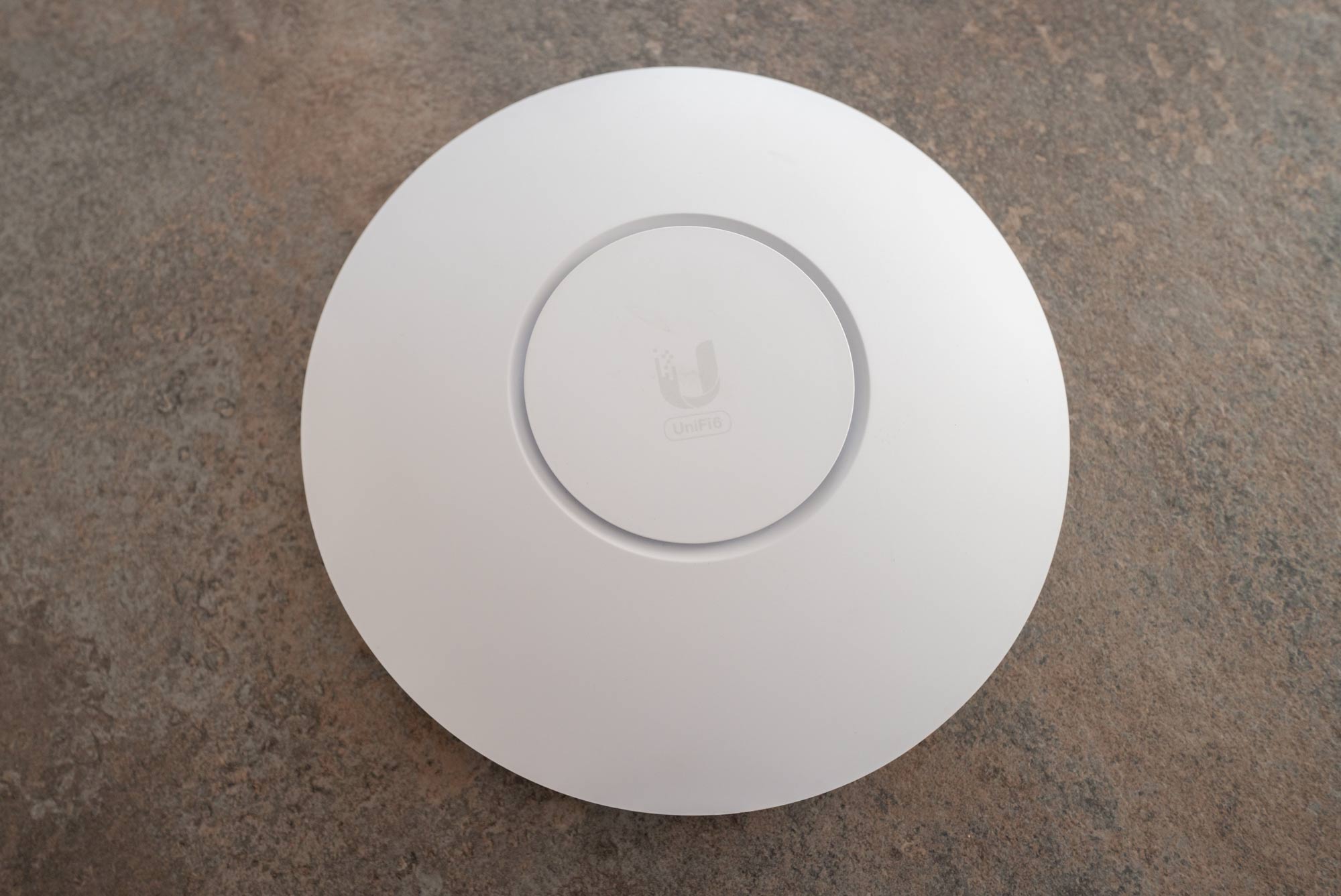
Ubiquiti has built up a well-deserved reputation for its Access Points among business users and ‘prosumers’ for delivering enterprise-quality equipment at affordable prices. With products like the UniFi AP AC LITE at about £70, it is possible to deploy a surprisingly cost-effective home or office Wi-Fi 5 network with several Access Points that will deliver more comprehensive coverage and consistent throughputs than possible with a single Wi-Fi router (even an expensive one equipped with Wi-Fi 6).
Some Wi-Fi manufacturers rushed to get Wi-Fi 6 routers to market, mainly in the form of premium-priced ‘gaming’ routers. We were generally unimpressed with the early devices, which displayed inconsistent performance and lacked key functionality (such as OFDMA support for the uplink). Spending your money on multiple, good-quality Wi-Fi 5 Access Points made much more sense and gave much better results.
In November 2020, Ubiquiti announced two Wi-Fi 6 Access Points:
- the UniFi 6 Lite Access Point, with 2 x 2 MIMO support
- the UniFi 6 Long Range Access Point, with 4 x 4 MIMO support.
Furthermore, there has been a steady increase in the number of devices that are compatible with Wi-Fi 6. For example, we’ve recently purchased an Apple M1 Macbook Air and iPhone 12 Pro Max, which are both equipped with Wi-Fi 6.
Since the official launch of Ubiquiti’s new Wi-Fi 6 Access Points, these two devices have become available sporadically in Ubiquiti’s Europe and USA Store. The products have gone in and out of stock since their initial announcement, so it is still very early days with Ubiquiti’s Wi-Fi 6 product line. We were provided with two UniFi 6 Long Range Access Points in early January and have been rigorously testing these since then.
Ubiquiti’s UniFi Wi-Fi 6 and Wi-Fi 5 products compared
For users wanting an affordable Wi-Fi 6 Access Point, the new UniFi 6 Lite offers excellent value for money with only a small price premium over Ubiquiti UniFi Lite Wi-Fi 5 product, as shown in Table 1, below. Both devices do not support 160 MHz channels but this is not a major issue, as discussed in our recent article What Realistic Speeds Will I Get With Wi-Fi 5 and Wi-Fi 6? If you are deploying multiple Access Points (and, if not, you really should be for maximum performance), there simply is not enough 5 GHz spectrum available to support 160 MHz channel bandwidths, and most client devices do not support 160 MHz channel bandwidths anyway.
The UniFi Lite has been a great entry point to Ubiquiti’s product line, and the UniFi 6 Lite is set to continue in that tradition. With superior efficiency, higher transmit power and higher maximum radio link speed, opting for the UniFi 6 Lite over the UniFi Lite seems a no-brainer. Even if you have no Wi-Fi 6 devices, the UniFi 6 Lite can operate in Wi-Fi 5 mode. Home users can deploy multiple UniFi 6 Lite Access Points at a very affordable price to deliver superb results. We think the UniFi 6 Lite is going to be very popular. The only challenge is getting hold of the new UniFi 6 devices.
| Model | UniFi Lite | UniFi 6 Lite |
|---|---|---|
| Wi-Fi standard | Wi-Fi 5 | |
| (802.11ac) | Wi-Fi 6 | |
| (802.11ax) | ||
| 5 GHz max radio link speed | 867 Mbps | 1201 Mbps |
| 5 GHz MIMO | 2 x 2 | 2 x 2 |
| Processor | Not specified | 1-core 880MHz |
| RAM | Not specified | 256MB |
| Weight | 170g | 300g |
| Max. power consumption | 6.5W | 12W |
| Max. transmit power | 20dBm | 23dBm |
| 5 GHz gain | 3dBi | 3dBi |
| LAN connections | Gigabit Ethernet (RJ45) port | Gigabit Ethernet (RJ45) port |
| Approximate price (incl. VAT) | £70 | £87 |
Table 1: Comparison of the Ubiquiti UniFi Lite and UniFi 6 Lite Access Points
In this article, we are reviewing the more expensive UniFi 6 Long Range (LR) Access Point. Our current Wi-Fi network consists of five UniFi (Wi-Fi 5) nanoHD Access Points, which we have been delighted with. We ranked the UniFi nanoHD top in our Best Wi-Fi Access Points For 2020. Given the price of the new UniFi 6 Long Range Access Point is very similar to the nanoHD Access Point, we have compared these two devices in Table 2 below.
| Model | UniFi nanoHD | UniFi 6 Long Range (LR) |
|---|---|---|
| Wi-Fi standard | Wi-Fi 5 | |
| (802.11ac) | Wi-Fi 6 | |
| (802.11ax) | ||
| 5 GHz max radio link speed | 1733 Mbps | 2.4 Gbps |
| 5 GHz MIMO | 4 x 4 | 4 x 4 MU-MIMO |
| Processor | Not specified | 2-core 1.35GHz |
| RAM | Not specified | 512MB |
| Weight | 300g | 800g |
| Max. power consumption | 10.5W | 16.5W |
| Max. transmit power | 26dBm | 26dBm |
| 5 GHz gain | 3dBi | 5.5dBi |
| LAN connection | Gigabit Ethernet (RJ45) port | Gigabit Ethernet (RJ45) port |
| Approximate price (incl. VAT) | £147 | £162 |
Table 2. Comparison of the Ubiquiti UniFi nanoHD and UniFi 6 Long Range Access Points
As shown in the photo below, comparing the UniFi 6 Long Range device ‘in the flesh’ (left) with the nanoHD unit (right) shows the UniFi 6 Long Range model to have a much larger form factor.
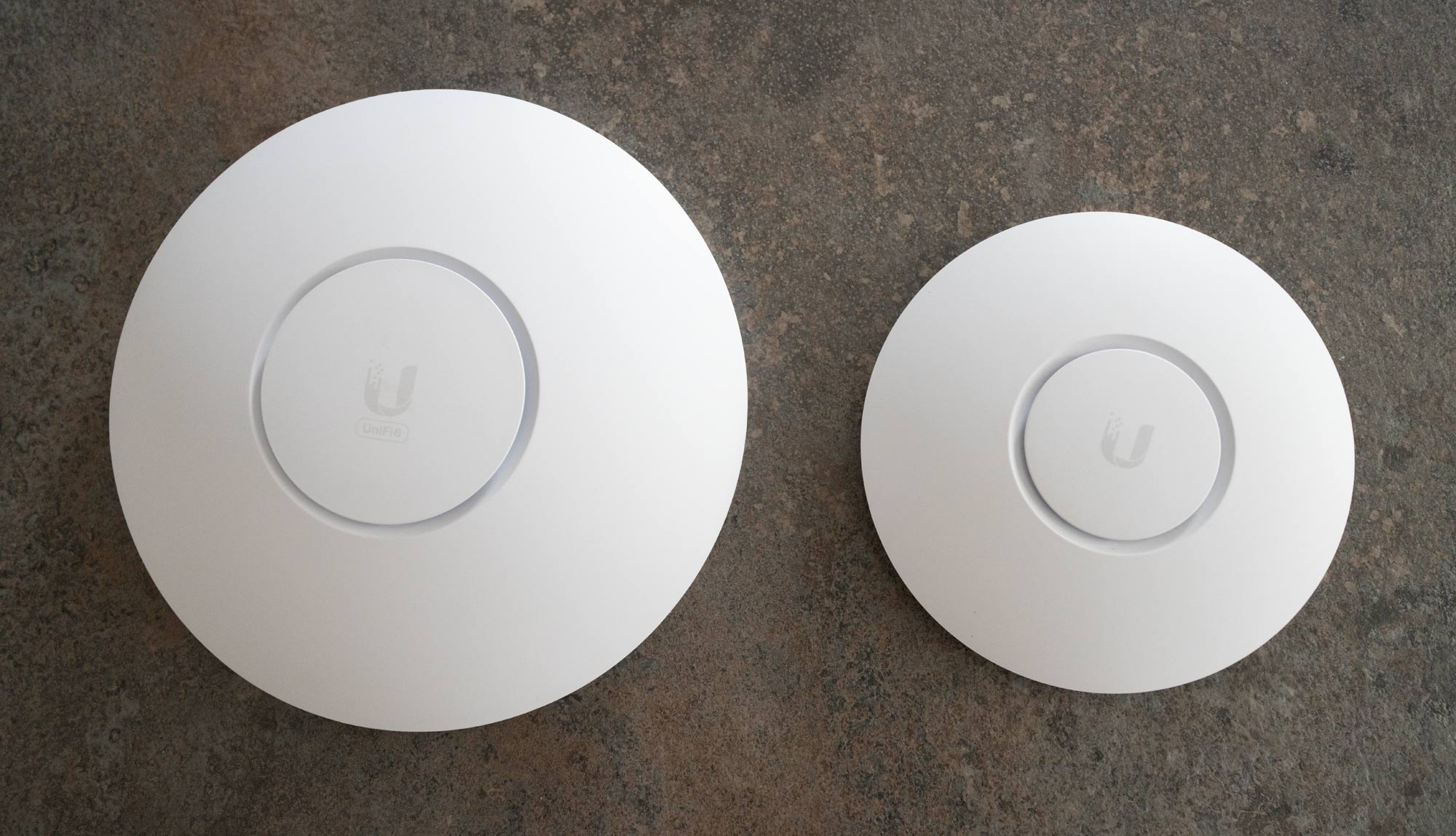
With a weight of 800g, the UniFi 6 Long Range Access Point is much heavier than the nanoHD (300g) and feels much more substantial. Both devices support 160 MHz channels in the 5 GHz band and 4 x 4 MIMO. With its higher antenna gain, the Uni-Fi 6 Long Range device should provide better range. While Ubiquiti has not specified the processor or RAM in the nanoHD, the LR unit has a 2-core 1.35 GHz processor with 512MB of RAM, which we assume is improved since Wi-Fi 6 is computationally much more intensive than Wi-Fi 5. Monitoring the CPU and memory usage of the UniFi 6 LR has shown no sign of the device being underpowered, with plenty of performance in reserve.
While we discuss the measured throughput performance later in this review, it is important to point out that the maximum radio link speeds given in the tables above will translate to significantly lower actual throughputs, as explained in our article What Realistic Speeds Will I Get With Wi-Fi 5 and Wi-Fi 6? Also, given that the UniFi 6 LR Access Point is connected to a network using Gigabit Ethernet then the maximum throughput achievable from the UniFi 6 LR is obviously the maximum throughput achievable through Gigabit Ethernet, which is about 940 Mbps, as described in our article What is a Good Signal Level or Signal-to-Noise Ratio (SNR) for Wi-Fi?
Ubiquiti’s UniFi Network Controller software is absolutely superb and provides huge flexibility
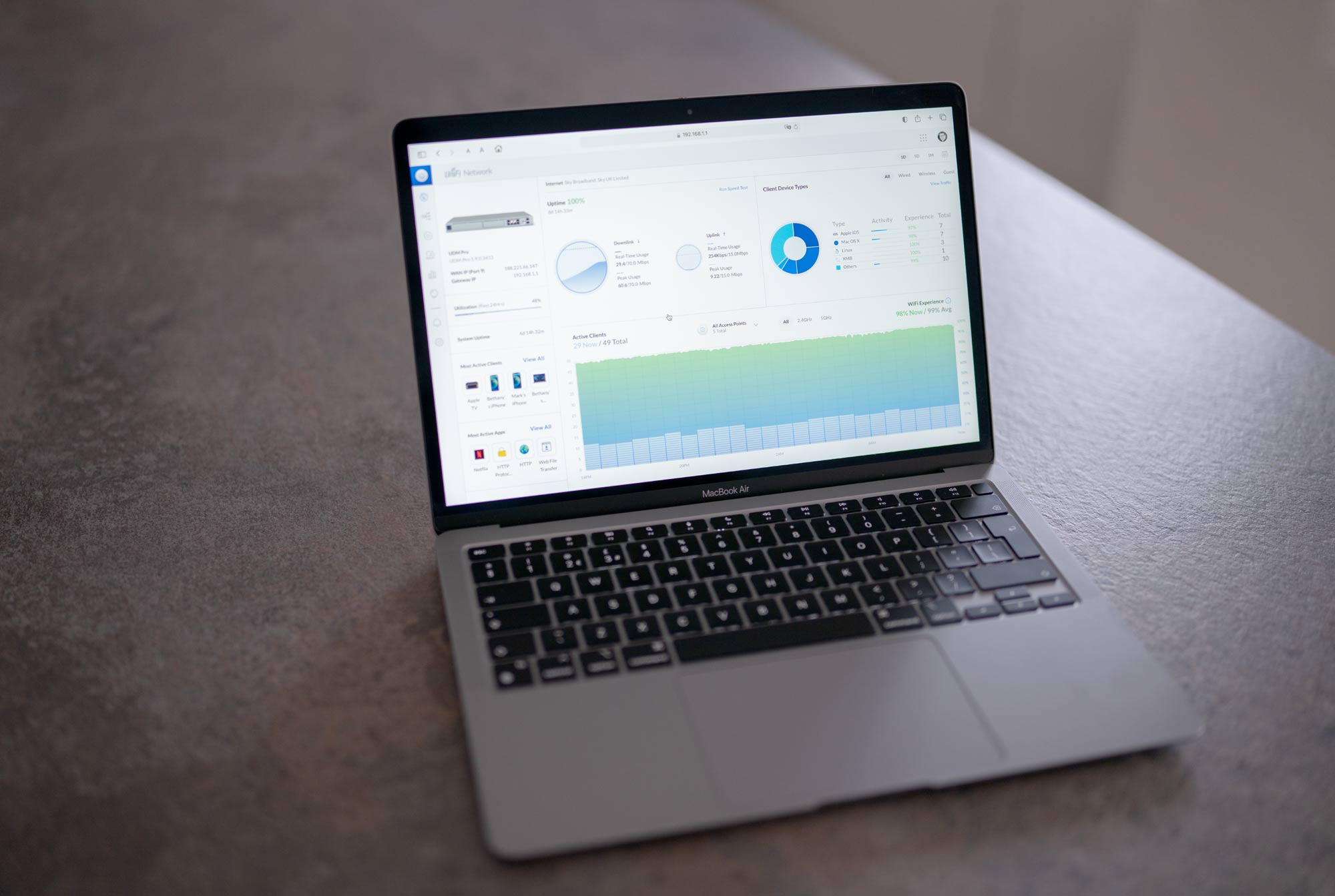
Before considering the performance of the UniFi 6 Long Range Access Point itself, we want to emphasise that one of the biggest advantages of this product is that it uses the powerful UniFi Network Controller software, which we love. This can be easily accessed via a browser or a mobile phone app – either when connected to your own local network or remotely (so you have full access and control when away from your home or office). The UniFi Controller allows you to configure a Wi-Fi network with ease and to fine tune the performance to deliver outstanding performance. We’ve really enjoyed tweaking our Wi-Fi network – to achieve a performance score of 100%.

For every single device and connection, data is collected and stored, allowing any issue to be identified and addressed. As an example, below is data collected for an Apple Macbook Air M1 (equipped with Wi-Fi 6 with 2×2 MIMO) operating to a UniFi 6 Long Range Access Point.
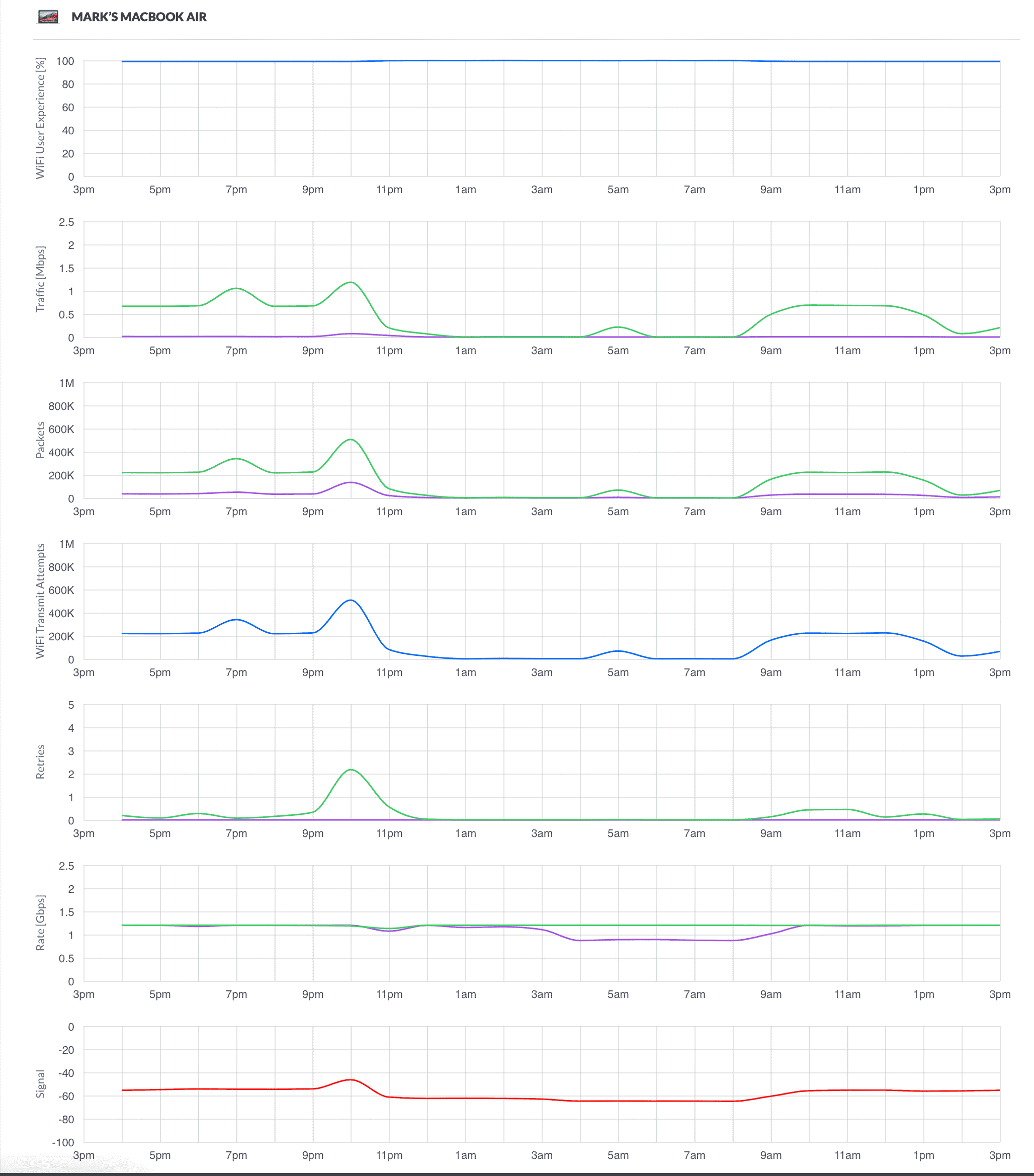
The system monitors different aspects of every connection, allowing you to identify and troubleshoot any issues that stand in the way of optimum performance. The excellence of the UniFi Controller software is one of the reasons why UniFi Access Points stand apart from so many alternative products. Ubiquiti’s UniFi system provides home users with ‘enterprise-class’ features and control at consumer prices.
The beauty of the UniFi Controller software is that it allows you to configure and manage different types and generations of UniFi Access Points, which gives immense flexibility on deployment. So, you have the choice of upgrading specific Access Points (for example, those carrying the most traffic) to Wi-Fi 6 devices while leaving older devices to serve lower-traffic areas. Even if you deploy Wi-Fi 6 everywhere, you could decide to deploy UniFi 6 Long Range Access Points in the most important locations while using lower-cost UniFi 6 Lite Access Points in less-important locations. Because of this flexibility, the UniFi system provides surprising cost-effective evolution for broadband users. Every time you upgrade, you won’t be throwing everything away and starting again.
Recently, we helped a neighbour configure a Wi-Fi router from Sky, and realised just how much more control you get with the UniFi system. The Sky Wi-Fi router only provided the opportunity to select non-DFS 5 GHz channels with 40 GHz and 80 GHz channel bandwidths, while the UniFi Controller allows you to set a raft of configuration options with the UniFi 6 Long Range Access Point, including:
- completely separate configuration for 2.4 GHz and 5 GHz bands
- selecting any 5 GHz non-DFS and DFS channel, with any channel bandwidth (from 20 MHz to 160 MHz)
- manually setting any value of transmit power
- enabling a minimum RSSI (Received Signal Strength Indicator) to prevent distant devices from connecting to the Access Point (to improve overall quality).
By being able to control transmit power and the minimum RSSI, it is possible to ensure that devices optimally operate to the best Access Point.
Being realistic about the speed benefits of Wi-Fi 6 over Wi-Fi 5
Before discussing the practical performance of the UniFi 6 Long Range Access Point, it is important to realise that, unlike previous iterations of Wi-Fi standards, increasing speeds to individual client devices has not been the overriding objective with Wi-Fi 6. Many of the benefits of Wi-Fi 6 are concerned with improving efficiency (when operating with a large number of client devices) and reducing power consumption, rather than increasing maximum speeds to individual devices. Having said this, the introduction of new modulation and coding schemes with Wi-Fi 6 (using 1024-QAM) does provide for modest speed improvements in excellent radio conditions.
Wi-Fi 6 incorporates a number of improvements over Wi-Fi 5, which include:
- Multi-User (MU) Orthogonal Frequency Division Multiple Access (OFDMA). This subdivides the Wi-Fi channel into smaller frequency allocations (called Resource Units). This capability permits an Access Point to synchronise communication with multiple individual client devices at the same time on the uplink and downlink, and is much more efficient than Wi-Fi 5 when it comes to sending and receiving small packets of data.
- BSS Colour. By assigning a ‘colour code’ to each Wi-Fi 6 Access Point or router, interference from surrounding Access Points or routers transmitting on the same channel (but different colour codes) can effectively be reduced.
- Target Wake Time (TWT). This reduces the amount of time that a client device in Power Save (PS) mode needs to be awake (and consuming power). This allows the device to ‘sleep’ longer and reduce energy consumption. This is really important for mobile devices where minimising battery consumption is critical.
- 1024-QAM modulation. Wi-Fi 6 introduces new modulation and coding schemes (MCS 10 and MCS11) that use 1024-QAM modulation when radio conditions are excellent (i.e. when the client device is located close to the Access Point). 1024-QAM transmits more data than the 256-QAM modulation used in Wi-Fi 5.
Rather than packing this review with a detailed description of Wi-Fi 6 and Wi-Fi 5, we have produced a separate article here, which we recommend that you read:
What Realistic Speeds Will I Get With Wi-Fi 5 and Wi-Fi 6?
In summary, actual throughput speeds with both Wi-Fi 6 and Wi-Fi 5 are affected by the following four things:
- the signal level (or signal-to-noise ratio)
- the channel bandwidth selected
- the MIMO capabilities of client devices
- the Ethernet connection on the UniFi 6 Long Range Access Point.
Each of these have profound implications for the performance of the UniFi 6 LR Access Point, as we will now discuss.
Just like Wi-Fi 5, Wi-Fi 6 employs a technique called ‘adaptive modulation and coding’, maximising the radio link speeds when signal conditions are excellent i.e. when client devices are located very close to the Access Point. Wi-Fi 6 adds an additional modulation scheme over Wi-Fi 5 (called 1024-QAM), which crams more data in than Wi-Fi 5, but only if radio conditions are excellent. So, given excellent radio conditions, Wi-Fi 6 should deliver noticeably faster speeds/throughputs than Wi-Fi 5. It is vital to realise that Wi-Fi 6 only performs at its best when client devices are very close to a Wi-Fi router or Access Point. We urge you to deploy multiple Access Points to ensure that your Wi-Fi 6 network operates at its fastest possible speeds.
Speeds increase for both Wi-Fi 5 and Wi-Fi 6 with increasing channel bandwidths. While the UniFi 6 LR Access Point supports 160 MHz channel bandwidths, the use of such wide bandwidths may not be possible in practice. Firstly, many Wi-Fi 5 and Wi-Fi 6 client devices only support a maximum channel bandwidth of 80 MHz. Secondly, if you are deploying multiple Access Points (and we strongly recommend that you do this), there will be insufficient non-overlapping 5 GHz channels to deploy multiple Access Points using 160 MHz channel bandwidths without Access Points interfering with each other. Realistically, 80 MHz channels are the maximum that could be achieved in many domestic deployments, and that is with DFS channels.
Speeds increase for both Wi-Fi 5 and Wi-Fi 6 with the number of MIMO spatial streams on client devices. Even though the UniFi 6 LR Access Point is equipped with 4×4 MIMO, maximum speeds to individual client devices will be determined by the MIMO capabilities of those client devices. A client device with 3×3 MIMO will deliver significantly greater speeds than one with 2×2 MIMO. However, many devices (such as modern mobile phones and laptops) only support 2×2 MIMO.
Even if very high maximum radio link speeds are claimed, real throughput speeds may be limited by the Ethernet connection to the Access Point. Ubiquiti claims that its UniFi 6 Long Range Access Point delivers a ‘radio rate’ of up to 2.4 Gbps in the 5 GHz band. However, since the UniFi 6 Long Range Access Point is equipped with a single Gigabit Ethernet connection, the maximum throughput – determined by the speed limitation of the Gigabit Ethernet connection itself – is about 940 Mbps.
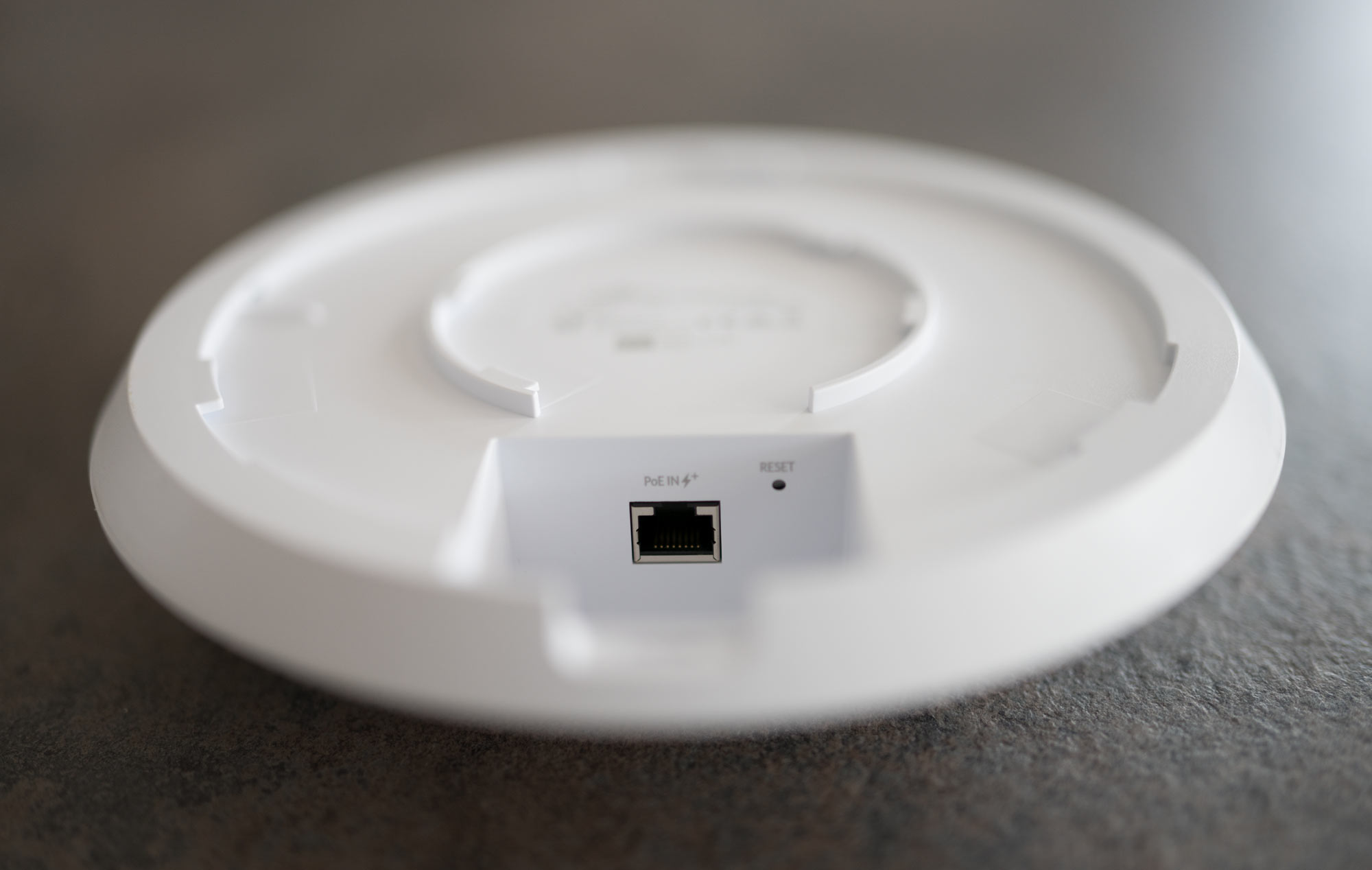
The performance of the UniFi 6 Long Range Access Point in practice
We found that the UniFi 6 Long Range Access Point delivers excellent performance in both Wi-Fi 5 and Wi-Fi 6 operating modes, and range is noticeably superior to the similarly-priced UniFi 5 Nano Access Point (as would be expected by the higher transmit power). Given that the prices of these two units are so similar, we have no hesitation in recommending the UniFi 6 Long Range unit as the preferred choice. The UniFi Nano Access Point is the top recommendation in our Best Access Point for 2021. The UniFi 6 Long Range Access Point becomes our top recommendation in our forthcoming Best Access Point For 2021 guide. The only challenge is getting hold of this unit, as it has been in very short supply for many months. During this time, Ubiquiti has had the opportunity to sell a huge number of these units and it seems a bit crazy that the supply shortage has lasted for such a long period.
As expected, the performance of the UniFi 6 Long Range Access Point was determined by:
- radio conditions, with the best speeds obtained when the client device was situated close to the Access Point. By using multiple Access Points, we were able to ensure that the UniFi 6 Long Range Access Point operated in its highest speed mode (using 1024-QAM modulation) in all our targeted locations
- the channel bandwidth used, with our best results achieved with an 80 MHz channel bandwidth. Using DFS channels, we were able to operate five Access Points in our Wi-Fi network without using overlapping channels
- the MIMO capabilities of client devices, with our speeds consistent for the client devices we used, which were both equipped with 2×2 MIMO (Apple iPhone 12 Pro Max and an Apple Macbook Air M1). While 3×3 MIMO could have achieved higher radio link speeds, these would not have resulted in higher throughputs due to
- the Gigabit Ethernet connection on the UniFi 6 Long Range Access Point. The Gigabit Ethernet connection effectively sets a maximum throughput of 940 Mbps irrespective of the radio link speed. Achievement of throughputs in excess of 1 Gbps necessitates connectivity that is superior to a single Gigabit Ethernet connection. Perhaps Ubiquiti will launch future Wi-Fi 6 produced with enhanced Ethernet connectivity.
In our configuration (using 80 MHz channel bandwidths and 2×2 MIMO client devices), we were able to consistently achieve throughputs of about 920 Mbps (as measured by iPerf3), as shown in Figure 1, below. This performance is very similar to a Gigabit Ethernet connection. Previously, using UniFi Nano Wi-Fi 5 Access Points, we were able to consistently achieve throughputs of about 640 Mbps. We think this is a really impressive result. We think that the UniFi 6 Long Range Access Point will appeal to anyone that is lucky enough to have a Gigabit broadband connection as the the unit is able to pass the full speed of such as connection.
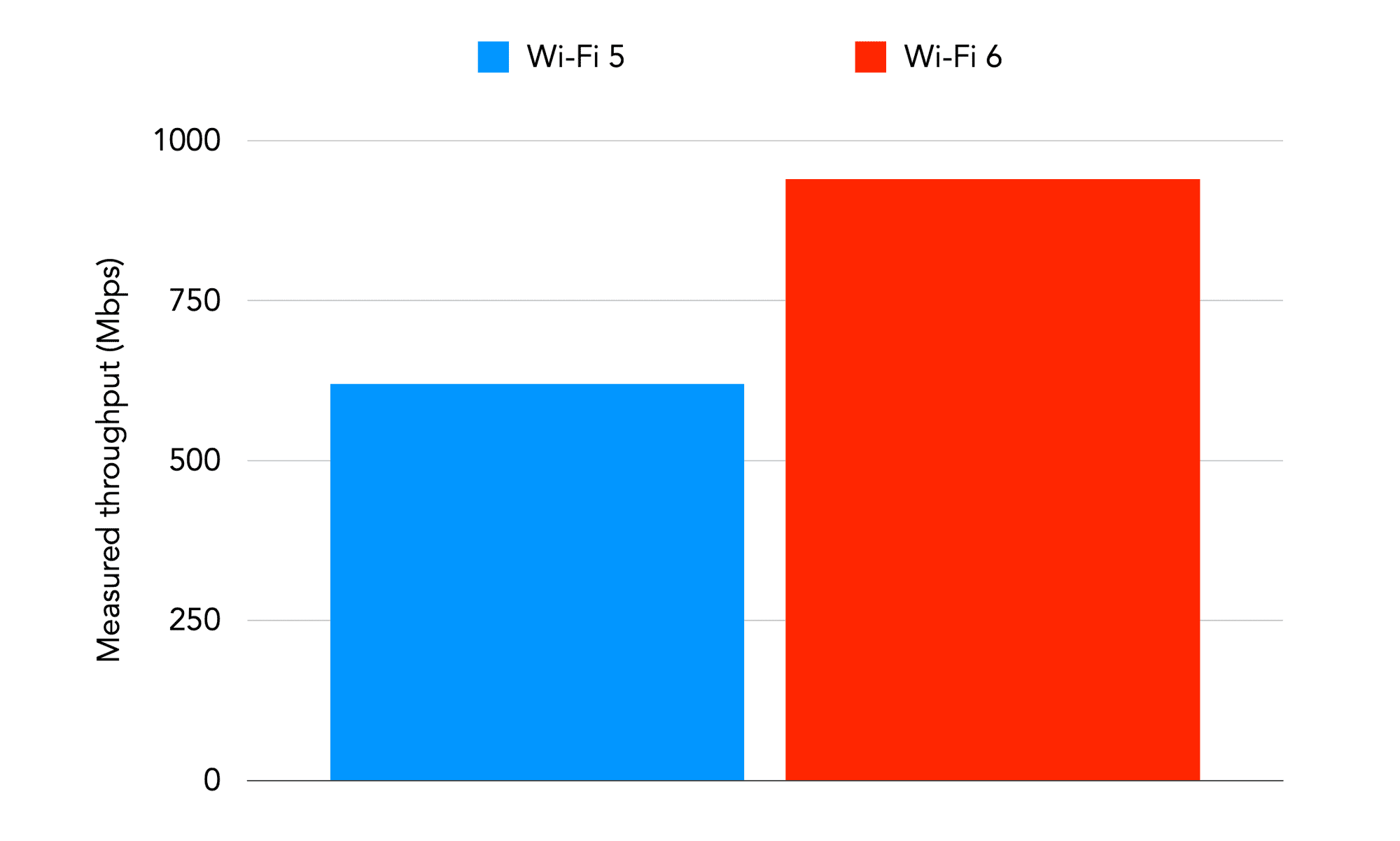
Figure 1: Measured Throughput for iPhone 12 Pro Max (with 2×2 MIMO) for UniFi 6 LR (Wi-Fi 6) and UniFi nanoHD (Wi-Fi 5)
Conclusions
After waiting some time for Ubiquiti’s new Wi-Fi 6 Access Points, the wait has certainly been worthwhile for those wanting solutions that extract the best performance now from a home or business network. While there is always something around the corner – such as Wi-Fi 6 products equipped with more than a single Gigabit Ethernet connection or Wi-Fi 6E devices offering enhanced deployment flexibility with ample 6 GHz spectrum – this should not take away from the excellence of the UniFi 6 Long Range Access Point. During several months of testing, performance and reliability have been outstanding. At its current price level, the UniFi 6 Long Range Wi-Fi Access Point represents excellent value for money.
Compared with Ubiquiti’s nanoHD Wi-Fi 5 Access Point, for little more money, the UniFi 6 Long Range Access Point provides future proofing, noticeably higher speeds with Wi-Fi 6 devices and improved range. For anyone looking for a new Access Point now, opting for the UniFi 6 Long Range Wi-Fi Access Point is a no-brainer. While Wi-Fi 6 is more about efficiency improvement rather than speed enhancement, we still measured significant throughput increases. With modern Apple devices (equipped with 2×2 MIMO), we measured real, close-range throughputs of over 900 Mbps, compared with about 640 Mbps achieved with the nanoHD Access Point. In other words, throughputs nearly match Gigabit Ethernet, which is a very impressive result. So, optimally deploying several UniFi 6 Long Range devices in a home or business would finally do full justice to the fastest ultrafast broadband connections.
It is really important to emphasise that bolstering signal levels by deploying multiple Access Points will provide huge benefit to those currently running a single Wi-Fi router, irrespective of whether these are Wi-Fi 5 or Wi-Fi 6. Choosing Wi-Fi 6 provides the ‘icing on the cake’ for those deploying multiple Access Points. However, don’t think that the use of single UniFi 6 Long Range Access Point will deliver improved performance over operating multiple Wi-Fi 5 Access Points.
If you already run optimised Wi-Fi 5 Access Points and are happy with the performance, you don’t need to be in a rush to upgrade all your existing equipment. As the UniFi ecosystem allows you to mix Access Points, upgrading Access Points in high-traffic areas to Wi-Fi 6 may provide a cost-effective evolution path for many.
The big question is whether you should wait for the arrival of Wi-Fi 6E products using 6 GHz radio spectrum, which will release users from the restrictions of limited 5 GHz spectrum and the need to use DFS channels. To us, the gains from Wi-Fi 6 are significant and worthwhile. It really depends on your current Wi-Fi network. If you are currently using the single Wi-Fi 5 router provided by your broadband provider, then what are you waiting for? Bolstering coverage and speeds by investing in multiple UniFi 6 Long Range Access Points will make a huge difference. At the other extreme, if you currently have multiple Wi-Fi 5 Access Points, a modest broadband connection and are really happy with your current performance, you may wish to wait for Wi-Fi 6E products.
Overall, we highly recommend the Ubiquiti UniFi 6 Long Range Access Point – our Best Access Point For 2021.
Other pages you may be interested in:
Review of UniFi UDM Pro | Increase Broadband Speed Guide | What Realistic Speeds Will I Get With Wi-Fi 5 and Wi-Fi 6? | How to Set Up and Improve Wi-Fi
